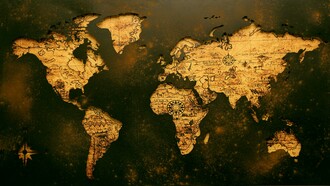We must become the change we want to see.
(Mahatma Gandhi)
Nothing new. The "curse of natural resources" is inexorably fulfilled every day and in every place where they exist. They are the resources that give life to the planet, energy generation systems and that are mostly found in large quantities in places considered until today, peripheral.
The great events of history would not have happened there and until the beginning of the First Industrial Revolution they kept their resources in silence, in a latent state.
In 1760 the music began to change. From coal and its steam engines to lithium and cell phones, the four industrial revolutions have been carried out largely using natural resources: water, gas, oil, fossil fuels ... to some virtually inexhaustible natural sources. They say.
The African continent, the most to hand, "shotgun", has historically been overwhelmed by European countries and their companies. And Latin America, stripped of its precious metals, from gold to lithium, today, curled up under the suffocating wing of the United States has not been left behind. Continents rich in natural resources and impoverished in their humanity.
The indigenous people that have been left out of the advantages of industrial revolutions are disappearing, they are being depleted along with natural resources: greater extraction, greater ecological damage and greater poverty. Or rather, the benefits produced by the greater extraction of natural resources, fly away, without remaining and without local intermediaries.
Ashleigh Brilliant, writer and illustrator born in the cradle of the First Industrial Revolution, currently residing in the United States, the basis of the Fourth Industrial Revolution, has dedicated his life to suggesting correct aphorisms: “Money, not morality, this is the principle of civilized nations”.
In Colombia, a shaman tells us that the destiny of his people constantly taken advantage of will be exile, the only possible survival.
In this 21st century, the world wonders about the fate of the Amazon rainforest, as the effects of cutting down trees begin to be felt even in Australia.
In Chile, the Atacameño people have historically survived several invasions, but now, the lack of water usurped by the extractive industry of lithium has it at the limit of its survival. The indigenous people have been and are, until now, taken advantage of, annihilated by a view that has seen progress at any cost a way of being in the world.
However, what was only the periphery of life, although rich in natural resources, today is acquiring a desperate "centrality." The planet and its ecology ask for it: climate, air quality, crops, water, tides. When talking about the "issue of the environment," nothing is left out. Even the poles and their "eternal" ice are at stake. Although the fate of the indigenous peoples continues to be in the balance, they have not stopped suffering the curse of inhabiting areas with natural resources. Little or nothing has been known about those "peripheries." The important things have taken place in the "center,” where the planet’s destinies have been played out. Today, the destinies of the planet pass by listening and making visible the peripheries: they have acquired their own centrality since the quality of the environment has taken on relevance for life.
Today we know that an earthquake in Thailand with or without a tsunami, a coup in this or that country, an iceberg that melts in Iceland with starving polar bears, a great fire here or there, or an orangutan that died of old age in a zoo in a major European city or riddled in a Borneo reservation affects everyone's life. And the international stock market. Definitely. The famous butterfly effect, where the flapping of its wings generates a tornado in the other part of the planet?
But still, in this entire, round and global world, filters are created that make it invisible or difficult to understand. For Ashleigh Brilliant it's a matter of speed: "Some changes are so slow that you don't notice it, others are so fast that they don't notice you."
It remains to be seen what is happening with those groups of people who have managed to live and survive despite this state of affairs. In general, they are indigenous people with their cultures of survival, communication and exchange, who, living in close relationship with their contexts, contribute different perspectives on a way to be in the world. An enormous wealth that, together with the flora and fauna of these places, is a contribution to the cultural wealth and ecology of the planet.
Socaire, a community facing current problems
From this point of view, what is happening in the Atacama desert is not different from what is happening in the Amazon. A global problem that manifests itself locally, but that compromises the stability and biological life of the entire planet, such as the described deforestation of trees in the Amazon.
The Atacameño world has not been absent from this process. Since its origin, one thousand years B.C. it has survived because it has known how to adapt to changes that have been imposed on it from outside, sometimes with violence: the Inka invasion in the 13th century, the Spanish in the 16th century, the nascent American republics in the 18th century.
Today the world presents new problems that they will have to face in order to survive. It is known that they are not the only ones. They are problems that manifest themselves in many places on the planet:
- Climate change
- Water scarcity
- The pressure of large-scale mining
- The irresponsible tourism boom
In this, they are no longer alone, because the old "peripheries" have occupied their own center. What happens in them affects and conditions life at the center. When the planet is surveyed in environmental terms, the world has become one and global "listening" has become essential.
Climate change is one of the problems they have had to face with the instruments provided by their own culture and their deep knowledge of the territory: the desert "feels" more arid.
The seasons of the year have shifted and their crops and animals are slowly disappearing. They suffer. They suffer Climate change without being able to count on great palliatives.
On the other hand, Chilean and foreign companies that exploit lithium in the Salar de Atacama, extract from their bowels 1,820 liters of salt water and 320 liters of fresh water a second.
Beneath the salt flat, a huge natural underground saltwater reservoir contains dissolved lithium salts. To extract them, the mining companies pump this brine to the surface, where it evaporates with the sun, so that the lithium carbonate is ready to be collected.
Water becomes scarce: due to a system of communicating vessels, if its level drops in the valley (in the Salar), it also drops above, in the mountains, where the inhabitants of Socaire reside and where the slopes that bathe the valleys exist.
Unanswered Question: What is the natural reserve of the entire hydrographic basin?
But also the pressure of mining that asks for territorial concessions for economic production in lands that the Socaire community has historically considered "sacred" and that ancestrally belonged to it. To counteract this, the Socaire community is locating various projects "scattered" throughout the territory. A strategy to recover your own.
That’s not all: in recent years, Chile has successfully promoted internationally "adventure tourism", taking advantage of the low habitat density of the territory and the characteristics of its geography, producing a tourist boom in the desert Atacama: an Ibiza of the desert! Only that tourism model, data from international organizations at hand, leaves less than 10% of the business in the hands of the inhabitants of the place. The rest is absorbed by the transportation system, tour operators and various intermediaries. The community, powerless, notices the degradation in the sacred landscape: tourists dumping rubbish anywhere or kitesurfing in the salty lakes, scaring away the flamingos. Like climbing a stone wall inside a gothic church while mass is being celebrated. Sacred places. Both of them.
They opt for a friendlier concept: "traveller or visitor" rather than "tourist", with whom it is possible to dialogue and confront, and not only be passive towards others. "Responsible tourism", a concept that already occupies an important place in the global economy.
The community of Socaireños wants a long-term social and territorial project based on its own natural and cultural resources.
A continuity with what they have been building over time with materials typical of the desert: earth and stone. With the water coming from the springs that arise at the base of the nearby volcanoes and that lead through channels to irrigate their terraced crops, a system that has always been maintained: its agriculture and livestock.
To face change, they have a pragmatic vision of the world.
In the desert north of Chile, Socaire, a village of 800 inhabitants at 3,600 meters above sea level, on the eastern shore of the Salar de Atacama, is ready to face these new challenges.
Powerful lithium mining imposes conditions that the community, perplexed, is not entirely willing to accept. There is concern about the impact that saltwater extraction is having on the ecosystem, but also, and most pressing for them, is that mining companies are also aggressively accessing freshwater supplies.
Grace Livingstone, professor at the Center for Latin American Studies at the University of Cambridge, in August 2019 conducted interviews with inhabitants of the towns around the Salar and with a bureaucrat from the Chilean Government.
For Sara Plaza, from the town of Peine, “there used to be beautiful lagoons down there, with hundreds of flamingos. Now it is all dry and the birds are gone. It was so green, now it is hard and cracked terrain. We can no longer keep flames”.
Jorge Cruz, from Camar, notes that if the mining companies continue to use fresh water at the current rate, their town will not survive. "The birds are gone, we can no longer have animals. It is increasingly difficult to cultivate. If it gets worse ... we will have to migrate. The government does not have a hydrological model of the entire aquifer”.
An official congressman declares that “as a mining country, Chile has had to balance the water needs of citizens with the demands of the industry. That the government will always guarantee that the communities have water and that the key is good regulation of the mining industry”.
However, he believes that the potential of lithium is too valuable to ignore. The price that Socaire and the other towns have to pay has not been given the value that it should have.
Spontaneously a sociologist friend asks me: what if the inhabitants of the Salar participated or were involved in the extraction of lithium? Using less environmentally aggressive systems?
The president of the Chilean mining society, Sonami, reassuringly ensures that the amount of fresh water used by lithium companies is insignificant. But he agrees that all water levels must be better monitored by authorities. This, in a country where the water of the lakes and rivers are private property!
Jorge Cruz can no longer raise animals due to a lack of fresh water.
And Sara Plaza is afraid: "They will leave us here without water, without animals, without agriculture, without anything."
The desert belongs to those who inhabit it, not to those who only exploits its natural resources.
Atacameños know that building a road has advantages and disadvantages. A "way to progress" serves to move and reach other places, true, although with it come aspirins, multicolour industrial wool, zinc plates, bottled liquors ... and tourists.
Socaire has been a kunza cultural refuge and facing change is an expression of vitality in Atacameño thought. It has never remained a passive actor in the face of change. Anthropologists agree.
A road or tourism is the same, the mechanism works as a hinge: Socaire has remained alive despite successive cultural stratifications, transfers, losses and annexations. It has managed to get around colonialism and modernity, it has functioned as a refuge for its own culture. It has sought integration incorporating elements of the dominant culture.
The construction of a path indicates the existence of an Atacameño way of thinking or living, which is that of the person who builds it, and which, as in the past, “continues to be a new aspect of the Atacameño tradition of adaptation to an inhospitable environment.” It is the challenge of inhabiting the desert.
To receive visitor flows, the Socaire community is preparing. They are unwilling to leave their “sacred” territory to others. Whoever visits it should look at it through the lens of their own culture. Above all, because conventional tourism is a beast that should be kept at a distance: most of the profits go down to the valley. Little remains up there in the mountains. This is why responsible 'sustainable tourism' is one of the priorities of the United Nations.
The present project, prepared jointly with the inhabitants of Socaire, wants to account for this situation.
The tourist as "traveller or visitor”, guided by an inhabitant of the place capable of narrating it and revealing its secrets. Not all are, of course.
The trip to the Atacameño universe is that, capable of making people, and its own inhabitants being who teach it, abandoning tourist guides in uniforms and in six languages, because the sacredness of their territory has been lived and practiced by the Atacameño people for centuries. And if there is something to tell the planet about the mountains, the volcanoes, the water that rises and runs guttering, of life in the desert, they should be in charge of doing it.
Life in the desert, the search for emptiness, a place where the limit of the human condition is lived. In the desert everything begins, a metaphor for the possible, for what needs to be done to exercise life. Their dark things tend towards clarity. The beauty of life is done by taking away, rather than adding: silence is part of it and the singing and dancing of religious festivals also confirm it. Silence as a lair against the siege of hostile words.
In this vast landscape, not only nature is present, but also the work of man without cement. Along with the heat and the wind on the face, there is the work found in the mountains, on the trails, in the terraces, in its plants and trees, in its animals: stone walls, irrigation channels, the aroma of the crops and their animals. The desert offers the possibility of re-humanizing speed, restoring meaning to words, metaphors, singing... so as not to lose the sense of what is human.
A common Project
Together with the Atacameña Community of Socaire, as professionals1 we are tackling this project convinced that only with the participation of the inhabitants of the place will it be possible to carry out an initiative that takes into consideration the territory itself, its inhabitants and all living beings that inhabit it.
Together, aware that architects have not participated in more than 80% of what has been built on the planet. More than 90% live and work in the richest and most urbanized areas in the world.
We work convinced that in each place, the inhabitant and the professionals together, can identify actions to face and solve problems that have to do with each territory, with life in the places.
Socaire, like every new project, becomes an inclusive proposal, in which all actors have an important role. Without pre-established proposals, the language is invented or adapted each time.
1 The architects of the project are: Cesar Vergara, Freddy Lara, Javiera Fuentes, Lorenzo Berg, Renato Vivaldi, Santiago Naudon, Stephan Püschel, Isabel Herrera and Soledad Díaz (Aldea Foundation).















